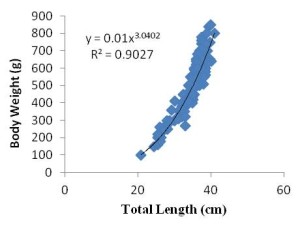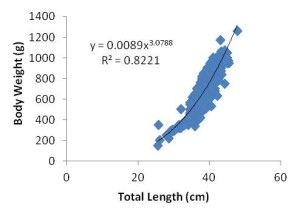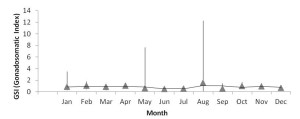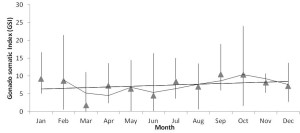Length-weight relationship and GSI of hilsa, Tenualosa ilisha (hamilton, 1822) fishes in Meghna river, Bangladesh
Volume 2, Issue 3, May 2015, Pages 82–88
Flura1![]()
![]() , Muhammad Zaher2, B.M. Shahinur Rahman3, Md. Anisur Rahman1, Mohammad Ashraful Alam1, Md. Mehedi Hasan Pramanik1
, Muhammad Zaher2, B.M. Shahinur Rahman3, Md. Anisur Rahman1, Mohammad Ashraful Alam1, Md. Mehedi Hasan Pramanik1
1Bangladesh Fisheries Research Institute, Riverine Station, Chandpur-3602, Bangladesh
2Bangladesh Fisheries Research Institute, Mymensingh 2201, Bangladesh
3Bangladesh Fisheries Research Institute, Shrimp Research Station, Bagerhat-9300, Bangladesh
| ABSTRACT | Get Full Text PDF |
The hilsa shad, Tenualosa ilisha (Hamilton, 1822) is an important anadromous clupeid fish species from the western division of the Indo-Pacific region. The present study dealt with the length weight relationship and GSI of hilsa shad using monthly samples over a calendar year from January to December 2013 from the river Meghna flowing through Chandpur district in Bangladesh. A total of 517 specimens (171 male and 346 female) of hilsa were collected. The reproductive characteristic of T. ilisha showed M: F=1:2 sex ratio which indicating predominance of females over the males. The parameter values of the equation W=aLb describing the relationships between total body weight (BW) and total length (TL) for male and female varied monthly. The generalized length-weight relationship was fitted with the pooled data of all monthly samples for male and female separately. The generalized length-weight relationship was fitted with the pooled data of all monthly samples for male and female separately which were BW = 0.01TL3.040 (R2=0.902) and BW = 0.008TL3.078 (R2=0.822) respectively. The results revealed that all length-weight relationships were highly correlated (r>0.891). Gonadosomatic index (GSI) was found highest in October and values ranged 1.6 -24 in female in case of male values ranged from 0.67-1.5 from and the lowest in December. The present data on male, female and combined fish functional length-weight relationships are important for fish stock assessment. These results will be helpful for fishery managers to impose adequate regulations for sustainable fishery management in Bangladesh.
Key words: Hilsa shad, Tenualosa ilisha, length-weight, GSI, Meghna river, Bangladesh.
![]() Corresponding author.
Corresponding author.
E-mail address: flura_bfri@yahoo.com (Flura)
How to cite this article: Flura, M Zaher, BMS Rahman, MA Rahman, MA Alam and MMH Pramanik (2015). Length-weight relationship and GSI of hilsa, Tenualosa ilisha (hamilton, 1822) fishes in Meghna river, Bangladesh. International Journal of Natural and Social Sciences, 2(3): 82-88.
INTRODUCTION
The country’s most important aquatic resource is the ilish (hilsa shad). It is the largest and single most valuable fishery in Bangladesh and an important fishery in India, Myanmar, Malaysia, Vietnam, and Iran, Kuwait and Iraq in the Middle East (FAO, 1974). Average hilsa production in Bangladesh is about 351 thousand metric ton (MT). Hilsa contributes 1.0% to the GDP (DoF 2014). It is the national fish of Bangladesh and the largest single species fishery contributing 75% of total catch in this region (Raja 1985) that accounts nearly half of the total marine catch and about 12-13% of total fish production of the country (Haldar, 2008). At present about 0.46 million people directly or indirectly are engaged in hilsa and jatka fishing.
A considerable amount of hilsa is exported from Bangladesh and the foreign currency is earned equivalent to about Tk.1500 million. Hilsa is mainly exported to West Bengal, India and some other countries in the Far East and Middle-East, European Union, America and Australia. Its marine distribution extends from Iran and Iraq in the Persian Gulf to the west coast of India in the Arabian Sea and the Bay of Bengal (Ahmed et al., 2008). Hilsa shad supports a commercial fishery and in the early 1970s composed more than 95 % of the total commercial catch in Bangladesh (Coad et al., 2003). The fishery provides livelihood to about 2.5 million people (about 2% of the total population) directly or indirectly (Mazid et al., 2007). T. ilisha is a very important food fish in south- west of Iran. The Hilsa shad is an anadromous species, but two other ecotypes – a fluvial potamodromous type and a marine type have been recognized. The potamodromous stocks appear to remain in the middle reaches of the rivers throughout the year and breed there in. The anadromous stocks, whose normal habitat is the lower region of the estuaries and the foreshore areas, ascend the rivers during the breeding season and return to the original habitat after spawning (Panhwar et al., 2011). Therefore, the exact stocks are still in dispute. As for other tropical fish, ageing of hilsa is problematic, because of the absence of annual rings on scales (Rahman and Cowx, 2006). However, length-weight relationship is an important tool in fish biology, physiology, ecology, fisheries assessment and fish conservation. In the present study, length-weight relationships of T. ilisha were estimated to know the status of the hilsa fishery in Bangladesh, which could be helpful for management of the fishery.
MATERIALS AND METHODS
Fish samples were collected month wise during January to December 2013 from the south part of Meghna river. A total of 517 specimens (171 male and 346 female) of hilsa ranging size from 20.9-47.8 cm in total length (TL) and 200-1260 g in total body weight (BW) were collected randomly for the analysis. The collection details of hilsa used for this study are given in Table 1. The total length was measured as the distance from snout to the tip of the caudal fin and body weight was taken with an electric digital balance for each fish after the specimens were dried on blotting paper.
The relationship between the total length (TL) and total body weight (BW) of fish was estimated by using the equation:
BW= aTLb
Where,
BW=Body weight of fish in (g)
TL=Total length of fish in (cm)
a=Constant (intercept)
b=an exponent indicating isometric growth when equal to 3.
The reproductive cycle of a species for the year round fortnightly or monthly intervals can be determined by gonadosomatic index (GSI). It is a very useful method to indicate the spawning season of the species at the field level. GSI assumes that a gonad increases in size with increasing development comparing with the mass of the gonad (GW) to the total mass of the animal (BW). The gonadosomatic index of each fish was calculated. The gonadosomatic index of each fish specimen in the study was calculated as GSI (%) = Gonad weight (g) × 100 / Body weight (g). The spawning seasons determined based on the monthly changes of GSI indices and proportions of each maturity stage (Zhang et al., 2009).
RESULTS AND DISCUSSION
A twelve months long experiment was performed with a view to observing length-weight relationship and GSI of Hilsa, T. ilisha fishes in Meghna river, Bangladesh. A total of 517 specimens (171 male and 346 female) were collected and analyzed (Figure 1). Total length and total body weight data of male hilsa fishes collected over the period from January to December 2013, power relationships between them were estimated as BW = 0.01TL3.040 (R2=0.902) (Figure 2).The parameters ‘a’ and ‘b’ in the power curve equation derived from length-weight relationships were estimated as: 0.01 and 3.04, respectively (Figure 2). The higher value of ‘b’ in males revealed that, the length-weight relationships might be affected by the general condition of appetite and gonadal contents of the fish.
The correlation coefficient (0.902) showed that there was a strong relationship between total length and total body weight in the sample and its positive value reflected that the slope is positive (Figure 2).
Table 1
Collection record of T. ilisha from January, 2013 to December, 2013.
| SamplingDate | No. ofMale | Size Range | No. ofFemale | Size Range | ||
| TL (cm) | BW (g) | TL (cm) | BW (g) | |||
| January | 19 | 30.2-36.5 | 300-500 | 25 | 25.7-45 | 350-1050 |
| February | 12 | 25.6-39.2 | 200-700 | 26 | 35-41.5 | 550-860 |
| March | 7 | 29.3-40.1 | 360-650 | 37 | 34.5-45.3 | 540-970 |
| April | 7 | 30.2-37.5 | 410-590 | 20 | 31.5-38.5 | 320-820 |
| May | 26 | 32.8-41 | 350-800 | 35 | 34.5-43 | 425-900 |
| June | 22 | 31.5-39.8 | 350-750 | 34 | 34-45.5 | 336-950 |
| July | 9 | 31.5-39.5 | 360-840 | 32 | 38.5-47.8 | 750-1260 |
| August | 11 | 32-40 | 350-850 | 29 | 35.3-44 | 600-950 |
| September | 19 | 26-37.5 | 220-750 | 29 | 34.5-43.5 | 490-1170 |
| October | 14 | 24.5-38 | 150-740 | 30 | 25.5-43 | 150-1000 |
| November | 16 | 20.9-39 | 300-750 | 33 | 28-39 | 250-860 |
| December | 9 | 32.7-39 | 390-800 | 16 | 36.4-41 | 600-985 |
Where, TL= Total length; BW= Body weight
Figure 1
Percentage composition of male and female T. ilisha
The relationships were significant at 95% confidence level for T. ilisha, with r2 values being greater than 0.196 and is applicable to the population as a whole. The coefficient of determination (0.902) explained that 90.20% of the variation in body weight was due to the variation in total length in the sample of hilsa, T. ilisha collected over the period from January to December 2013.
From the total length and total body weight data of female hilsa fishes collected over the study period, power relationships between them were estimated as TL = 0.008BW3.078 and R2=0.822 (Figure 3).
Figure 2
The generalized relationship between total body weight (g) and total length (cm) in the male, T. ilisha.
The parameters ‘a’ and ‘b’ in the power curve equation derived from length-weight relationships were estimated as: 0.008 and 3.07, respectively (Figure 3). The higher value of ‘b’ in females revealed that, the length-weight relationships might be affected by the general condition of appetite and gonadal contents of the fish.
Figure 3
The generalized relationship between total body weight (g) and total length (cm) in the female, T ilisha
The correlation coefficient (0.822) shows that there was a strong relationship between total length and body weight in the sample and its positive value reflected that the slope is positive (Figure 3). The relationships were significant at 95% confidence level for T. ilisha, with r2 values being greater than 0.196 and is applicable to the population as a whole. The coefficient of determination (0.822) explained that 82.2% of the variation in body weight was due to the variation in total length in the sample of hilsa, T. ilisha collected over the period from January to December 2013.
The length – weight relationship of male and female of T. ilisha showed that the growth is isometric. The correlation coefficient values were very close to 0.99, which indicates that the relationships between total length and weight of this species was highly significant (p<.05). This finding agrees with the results of Ahmed and Saha (1996). The results clearly indicated that the mean length of female was significantly higher than male T. ilisha (p<.05). Roomiani et al. (2014) also found same result for T. ilisha. Amin et al. (2009) showed that the exponent ‘b’ usually lies between 2.5 and 4. The value of ‘b’ will be exactly ‘3’ when the growth is isometric. The value of ‘b’ differs not only between species but sometimes also between the stock of the same species due to sex, maturity, seasons and even time of day because of changes in stomach fullness. The regression coefficient ‘b’ of the length-weight relationship of T.ilisha in the Khouzestan Province of Iran lies between 2.68 to 3.16 as Amin et al. (2005) suggested are reasonable values for this species. Another studies in Bangladesh and India (Ramakrishnaiah, 1972; Shafi and Quddus, 1974; 1978; Quddus et al., 1984b; Amin et al., 2002; 2004; 2005, Roomiani et al., 2014) found the ‘b’ of T.ilisha to be in the range 2.76-3.38. These values are similar to those obtained for Meghna river fishes from Chandpur.
The GSI value of male ranged from 0.11-12.3 (Figure 4). The GSI values in the months of March, June and July were small ranging from 0.3-1.16, 0.16-0.89 and 0.36-0.7 respectively (Figure 4). Specimens collected on January, February, April and December were more or less small and medium sized fish and GSI values varied from 0.26-3.53, 0.47-1.82, 0.61-1.43 and 0.36-1.18 respectively, and some large GSI values were also observed but these were in few fishes (Figure 4). Fish caught on May, August and October having medium and large GSI values ranged from 0.17-7.68, 0.16-12.3 and 0.55-1.67 respectively (Figure 4).
Figure 4
Monthly GSI variation in male, T. ilisha.
Figure 5
Monthly GSI variation in female, T. ilisha.
For female, the GSI values varied from 0.12-24 (Figure 5) throughout the sampling period. Specimens collected on March, April, May and August having small GSI varying from 0.12-11.05, 2.45-13.6.0.17-14.4 and 0.67-13.5 respectively; though there were some large GSI values but these were few (Figure 5). Female fish caught on September, October, November and December 2013 comprised medium and large GSI values varying from 5.97-18.96, 1.6-24, 5.27-10.71and 5.08-16.66 respectively (Figure 5). GSI values were in the months of June, July and February were having values ranging from 0.2-16.4, 3.64-15 and 0.59-21.5 respectively (Figure 5). Large GSI values were observed in the months of October and November in almost all cases.
The GSI values for females showed three peaks apparently, those were in June, October and February. The highest mean GSI value was calculated in October. Male GSI showed the peaks as well and those were observed in January, September and October having highest in September and second highest in October. Male and female GSI data graphed in Figure 4 & 5 illustrated the trend of spawning season of the species. Though the spawning of both male and female occurs concurrently, since monthly mean female GSI over the year peaked in October, therefore, October was primarily assigned to the spawning season of T. ilisha.
Studies on sex ratio in T.ilisha have been made by Shafi et al. (1974 and 1978), Quddus et al. (1984a), Amin et al. (2005). These authors have reported dominance of either males or females in some months or seasons and showed the observed sex ratio was significantly different from the expected ratio of 1:1. Roomiani et al. (2014) also found same result. The present findings on sex ratio are generally consistent with those studies.
Change of sex ratio corresponding to the body length is a vital parameter which may be directly related with growth rate, natural and fishing mortalities (Guoping et al., 2008). In this study, the sex ratio of T. ilisha was M: F= 1:2. This sex ratio was changed between different months, but female predominate males. Dominance of females over the males complies with the results of Amin et al. (2005) (males to females 1:5.09). Contradictory views have been expressed by previous investigations on the sex ratio of T. ilisha populations (Quddus et al., 1984a; Ahmed and Saha, 1996). These variations may be caused by males and females often moving in separate shoals. Several reasons suggested for the unequal sex ratios (Zhang et al., 2009).
Monthly variations in Gonadosomatic index (GSI) of both sexes were quite apparent (Roomiani et al., 2014). Maximum values were recorded in June and May for male and female, respectively. Changes in GSI indices are considered as a proof that maturation season from March and spawning started from April to July. Narejo et al. (2008) found values of gonadosomatic index (GSI) for male and female of T. ilisha from River Indus were recorded for six months during summer from April to September and in winter from October to March. It was observed that in the females of both types GSI values were higher in July and February 17.33 and 17.30, respectively. In summer increasing trends in GSI values were recorded in males and females from June to August with a peak in July, while in case of winter T. ilisha the GSI values were increasing from January to March with peak in February. But in the present study GSI was found highest in October and lowest in December. In can be concluded that data on male, female and combined fish functional length-weight relationships are important for fish stock assessment. This study will be helpful for fishery managers to impose adequate regulations for sustainable fishery management in Meghna river as well as other rivers of Bangladesh.
REFERENCES
Ahmed KK and Saha SB (1996). Length-weight relationships of major carps in Kaptai Lake, Bangladesh. NAGA, 19(2): 22.
Ahmed MS, Sharif ASM and Latifa GA (2008). Age, growth and mortality of Hilsa shad, Tenualosa ilisha in the River Meghna, Bangladesh. Asian Journal of Bio Science, 1: 69-76.
Amin S M N, Rahman, M. A., Haldar, G. C., Mazid, M. A. and Milton, D., (2002). Population dynamics and stock assessment of Hilsa Shad in Bangladesh. Asian Fisheries Science, 15: 123-128.
Amin SMN, Rahman MA, Haldar GC, Mazid MA, Milton DA and Blaber SJM (2004). Stock Assessment and Management of Tenualosa ilisha in Bangladesh. Asian Fisheries Society, 17: 50- 59.
Amin SMN, Arshad A, Haldar GC, Shohaimi S and Ara R (2005). Estimation of Size Frequency Distribution, Sex Ratio and Length-Weight Relationship of Hilsa (Tenualosa ilisha) in the Bangladesh Water. Research Journal of Agriculture and Biological Sciences, 1(1): 61-66.
Amin SMN, Arshad A, Siraj SS and Japar SB (2009). Population structure, growth, mortality and yield per recruit of segestid shrimp, Acetes japonicus from the coastal waters of Malacca, Peninsular Malaysia. Indian Journal of Marine Sciences, 38: 57-68.
Coad BW, Hussaina NA, Ali TS and Limburg KE (2003). Biodiversity, Status and Conversation of the World Shads. American Fisheries Society, Bethesda, Maryland, 123P
DoF (Department of Fisheries, 2014). Sharonika, Madsha Saptah-2012. Department of Fisheries, Ministry of Fisheries and Livestock, Government of Peoples Republic of Bangladesh, 67-69.
FAO (Food and Agriculture Organization), (1974). Species identification sheets for fisheries purposes FAO, Rome.
Guoping Z, Liuxiong XU, Yingqi Z and Liming S (2008). Reproductive Biology of Yellowfin Tuna T. albacares in the West- Central Indian Ocean. Oceanic and Coastal Sea Research. 7(3): 327- 332.
Haldar GC (2008). Hilsa Fisheries Conservation, Development and Management Technique. 40p
Hamilton F (1822). An account of the fishes found in the river Ganges and its branches. Edinburgh & London. An account of the fishes found in the river Ganges and its branches. : i-vii + 1-405, Pls. 1-39.
Mazid MAM, Rahman J and Mustafa MG (2007). Source and abundance of Jatka (juvenile hilsa, Tenualosa ilisha) in the Gajner beel, Sujanagar, Pabna. Bangladesh Journal of Fisheries, 30: 37-51.
Narejo NT, Lashari PK and Jafri SIH (2008). Morphometric and Meristic Differences Between Two Types of Palla, Tenualosa ilisha (Hamilton) from River Indus, Pakistan. Pakistan Journal of Zoology, 40(1): 31-35.
Panhwar Sk, Siddiqui G and Zarrien A (2011). Reproductive pattern and some biological features of anadromous fish Tenualosa ilisha from Pakistan. Indian Journal of Geo- Marine Sciences, 40(5): 687-696.
Rahman MJ and Cowx IG (2006). Lunar periodicity in growth increment formation in otoliths of hilsa shad (Tenualosa ilisha, Clupeidae) in Bangladesh waters. Journal of Fisheries Science, 81, 342-344.
Raja BTA (1985). A review of the biology and fisheries of Hilsa ilisha in the Bay of Bengal. Bay of Bengal Programme, BOBP/WP/37. Marine Fishery Resource Management in the Bay of Bengal, 66 p.
Ramakrishnaiah M (1972). Biology of Hilsa ilisha (Hamilton) from the Chilka Lake with an account on its racial status. Indian Journal of Fisheries, 19: 35-53.
Shafi M and Quddus MA (1974). The lengthweight and length – girth relationship and condition in Hilsa ilisha Hamilton–Buchanan (Clupeidae). Bangladesh Journal of Zoology, 2(2): 150-343.
Shafi M, Quddus MMA and Islam N (1978). Maturation and spawning of Hilsa ilisha (Ham.-Buchanan) of the River Meghna. Dacca University, B, 26, 63-71.
Quddus MMA, Shimizu M and Nose Y (1984a). Meristic and morphometric differences between two types of Hilsa ilisha in Bangladesh waters. Bulletin of the Japanese Society of Scientific Fisheries, 50(1): 43- 49.
Quddus MMA, Shimizu M and Nose Y (1984b). Comparison of age and growth of two types of Hilsa ilisha in Bangladesh waters. Bulletin of the Japanese Society of Scientific Fisheries, 50(2), 177-181.
Roomiani L, Sotudeh AM and Hakimi Mofrad R, (2014). Reproductive biology of Hilsa shad (Tenualosa ilisha) in coastal Waters of the Northwest of Persian Gulf. Iranian Journal of Fisheries Sciences, 13(1): 201-215.
Narejo NT, Lashari PK and Jafri SIH (2008). Morphometric and Meristic Differences Between Two Types of Palla, Tenualosa ilisha (Hamilton) from River Indus, Pakistan. Pakistan Journal of Zoology, 40(1): 31-35.
Zhang J, Takita T and Zhang C (2009). Reproductive biology of Ilisha elongate (Teleostei: Pristigasteridae) in Ariake Sound, Japan: Implications for estuarine fish conservation in Asia. Estuarine, Coastal and Shelf Science, 81: 105–113.











